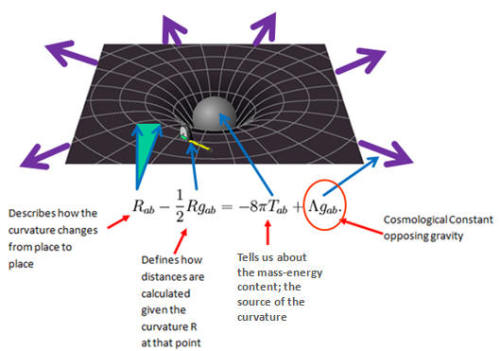Subscribe to the Grand Strategy Newsletter for regular updates on work in progress.
Discord Invitation
Post with 1 note
A Century of General Relativity

Today the world is celebrating one hundred years of Einstein’s theory of general relativity. It was on 25 November 1915 that Einstein wrote down the field equations that describe the large scale structure of the universe, according to which space and time are shaped by the presence of matter, and matter follows in the grooves of space and time.
While Einstein’s field equations are not as famous as E = mc 2, the field equations deserve at least equal billing, but the ideas they represent are arguably even more difficult than the idea of the convertibility of matter and energy represented by the more famous equation. Einstein knew that this theory was radical and presented a radically unfamiliar picture of the universe (I previously wrote about this in Radical Theories, Modest Formulations), but in the subsequent century we have been forced to accept the unfamiliar picture of the universe that Einstein first drew, and we have attempted to form new intuitions about space, time, and matter to find a way for the mind to grasp these strange truths in a way that makes sense to us.
While Einstein was the first to draw this picture, he was not the only one involved in the struggle to describe the large scale structure of the universe in mathematical terms. Einstein regarded himself as being in competition with the great mathematician David Hilbert, who had taken an interest in the problem:
“In the fall of 1915, however, he got dissatisfied with the Entwurf field equations. In November 1915, with the Göttingen mathematician David Hilbert breathing down his neck, Einstein dashed off a flurry of short papers to the Berlin Academy, in which he proposed, in rapid succession, three new field equations of broad and eventually general covariance. The final generally covariant equations are known today as the Einstein field equations.” (“No Success Like Failure …” Einstein’s Quest for General Relativity, 1907–1920, by Michael Janssen, in The Cambridge Companion to Einstein, p. 169)
While the name of David Hilbert is well known to mathematicians, he is not the icon to the general public that Einstein became, and still is today, as a consequence of his discovery of general relativity. It makes for an interesting counterfactual to imagine Hilbert having arrived at the Einstein Field Equations first, so that they instead might have been known as the Hilbert Field Equations, and Hilbert might have become the icon that Einstein became. Hilbert was arguably the greater mathematician, and Einstein arguably the greater physicist; either could have plausibly come to the same conclusion, but Einstein got there first.
What Hilbert and Einstein had in common was a rationalist’s faith in mathematics to reveal the innermost structure of the world. Einstein wrote in a letter that, “…the problem of gravitation has made me into a believing rationalist, i.e., one who looks for the only reliable source of truth in mathematical simplicity,” and shortly before his death Einstein wrote in a letter (of 15 February 1954) to De Broglie, “The equations of gravitation were only found on the basis of a purely formal principle (general covariance), that is to say, on the basis of trust in the greatest logical simplicity of laws of nature thinkable.”
Hilbert’s rationalism is expressed in his response to the Latin maxim, ignoramus et ignorabimus, which Hilbert controverted by asserting, “Wir müssen wissen — wir werden wissen!” (“We must know – we will know!”). This motto is carved on Hilbert’s gravestone. As a kind of manifesto of his faith in the solubility of mathematical problems, Hilbert formulated a famous list of 23 mathematical problems in 1900, now known as the Hilbert Problems, many of which have subsequently been resolved, but many of which remain as open problems, with mathematical fame guaranteed to anyone who provides a definitive solution to any of the remaining open problems.
Einstein’s particular take on formal rationalism was challenged in his lifetime by the emergence of quantum theory, which Einstein famously rejected as an incomplete description of reality. Hilbert’s particular take on formal rationalism was challenged in his lifetime by Gödel’s incompleteness theorems, the most obvious interpretation of which seemed to definitively give the lie to Hilbert’s ambition to give a complete description of mathematical reality in a formal system. We can see in both the work of Einstein and Hilbert not only a faith in rational inquiry, and a formal cast of mind, but also the demand for a formal solution that is at the same time complete and exhaustive.
Just as many of Hilbert’s problems remain unanswered, so too the relationship of general relativity to quantum theory remains unanswered in our time. Gödel’s work seems to suggest that there will always be unanswered questions in mathematics, hence any mathematical description of nature that aims at completeness will probably elude us. But formal rigor need not elude us, nor can or should the fruitfulness of the the rationalism of Einstein and Hilbert be lost on us.
bloodandhedonism liked this
geopolicraticus posted this